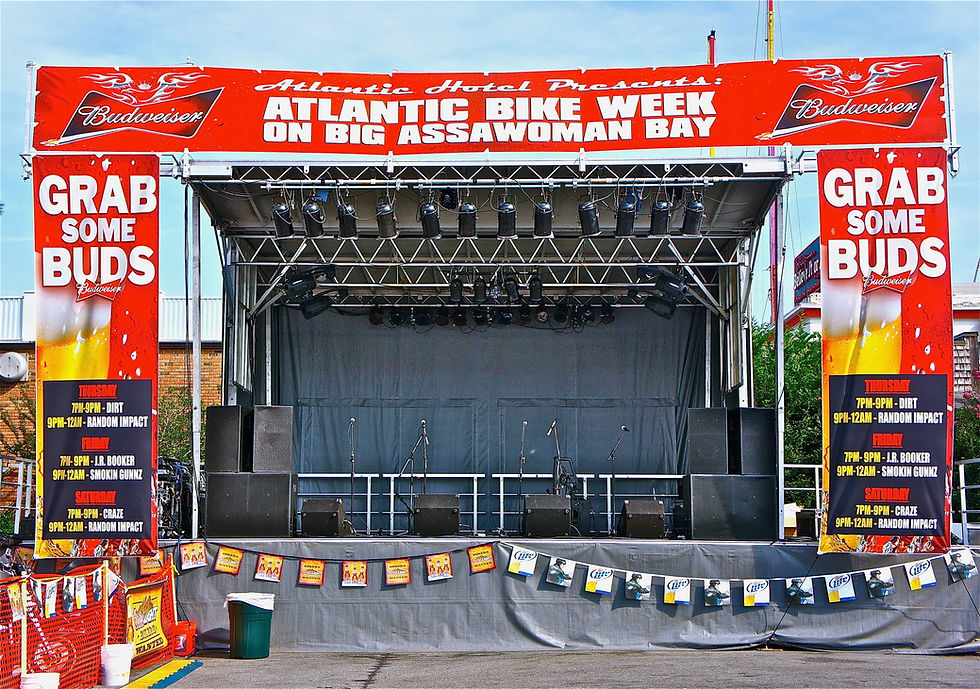The Hidden Risks of DIY Stages for Your Event
- Brad Richardson

- Jul 18
- 4 min read
Updated: Aug 4
Planning an event involves countless details, from decorations to catering. One critical element that is frequently overlooked is the stage. While some event organizers might consider a DIY approach to save money or create a unique look, building your own stage brings numerous hidden risks that can threaten the success of your event. Let’s explore the essential factors to consider before deciding to create a homemade stage for your next gathering.
Understanding the Risks of DIY Stages
At first glance, a DIY stage might appear to be a fun challenge. However, this approach often leads to unexpected complications. Constructing a safe and visually appealing stage requires specific knowledge, skills, and high-quality materials.
Building a stage without professional help can cause serious safety issues. If a stage is incorrectly measured or built with poor weight distribution, it risks collapsing. Data shows that structural failures at events can lead to injuries, with incidents increasing by 50% when safety protocols are ignored. Ensuring stability is not just about aesthetics; it can literally make or break the safety of performers and the audience.
Safety Concerns
Safety should always be the number one priority in event planning. However, homemade stages carry significant risks.
One major concern is the materials used. Many individuals underestimate the importance of selecting high-quality materials that can bear the weight of performers and their equipment. For example, a standard wooden stage platform can safely support up to 1,000 pounds if built correctly. In contrast, using improper wood or inadequate support systems could lead to instability and accidents.
Without a solid understanding of staging techniques, issues like insufficient lighting or trip hazards arise. Proper lighting not only enhances the performance but also helps prevent dangerous situations. Statistics reveal that inadequate lighting contributes to nearly 30% of all stage-related accidents, underscoring the importance of thoughtful design.
Time and Cost Considerations
While DIY solutions may seem like a budget-friendly option, hidden costs can emerge that catch organizers off guard.
The initial price of materials can be misleading. When calculating the total cost, think about supporting items like fasteners, tools, and safety gear. Additionally, the time invested in planning, constructing, and testing the stage may divert you from other crucial tasks, such as coordinating with guests or promoting the event. For instance, if constructing a stage takes two weeks, that’s two weeks of missed opportunities for other preparations.
Hiring experienced professionals can actually save you both time and potential costs. A study found that 75% of event planners reported fewer headaches—like safety incidents—after opting for professional services.
Liability Issues
Liability is a critical consideration when hosting any event. If an injury happens due to a poorly constructed stage, the organizer could face legal action.
Insurance may not cover accidents resulting from a homemade stage, especially if it fails to comply with safety regulations. For example, a single claim from an injury could lead to costs exceeding $100,000, far exceeding any initial savings from a DIY approach. It's essential to ensure that the chosen staging meets all necessary safety requirements to protect yourself.
Aesthetic Appeal and Functionality
A stage has a vital role in creating an inviting atmosphere.
Professionally built stages not only adhere to safety standards but also enhance the visual charm of an event. They can be customized to align perfectly with your theme, creating a cohesive experience. For example, a well-designed stage can elevate the perception of an event, improving audience engagement by up to 40%.
On the other hand, DIY stages may lack the professional polish that draws people in. An uninspired stage can fail to captivate the audience, detracting from performances and the overall event experience.
Alternatives to DIY Stages
Rather than risking it all with a DIY method, consider renting a professionally constructed stage.
Many companies provide a variety of staging options catering to different configurations and styles. This choice guarantees safety, functionality, and visual appeal while allowing you to concentrate on other crucial aspects of your event. Additionally, renting stages can be more environmentally friendly, supporting a network of specialized event services instead of contributing more waste.
Collaborating with Professionals
If you lean toward a DIY approach but wish to include personal touches, think about collaborating with professionals.
Hiring a stage designer or contractor offers valuable insights into suitable materials and construction techniques for your event. Their expertise can help reduce risks, allowing you to personalize your stage's appearance while maintaining safety standards.
Evaluating Your Event's Needs
Before making any decisions, take the time to assess your event's specific requirements.
Consider the type of performance, venue size, and audience demographics. A clear evaluation can guide you toward a stage solution that meets safety standards while fitting your budget and vision.
The Importance of Professional Staging
Investing in a proper stage setup is crucial for creating an atmosphere that resonates with your audience. Understanding the hidden risks of DIY staging will empower you to make informed decisions that lead to a successful and memorable event.
In summary, while building a DIY stage might seem appealing due to potential cost savings and the chance for creativity, the risks associated can jeopardize your event's success. Safety concerns, potential liabilities, and aesthetic shortcomings often outweigh the perceived benefits. The best approach is to assess your needs thoroughly and consider hiring professionals who can deliver safe, visually engaging, and effective stage solutions.




Comments